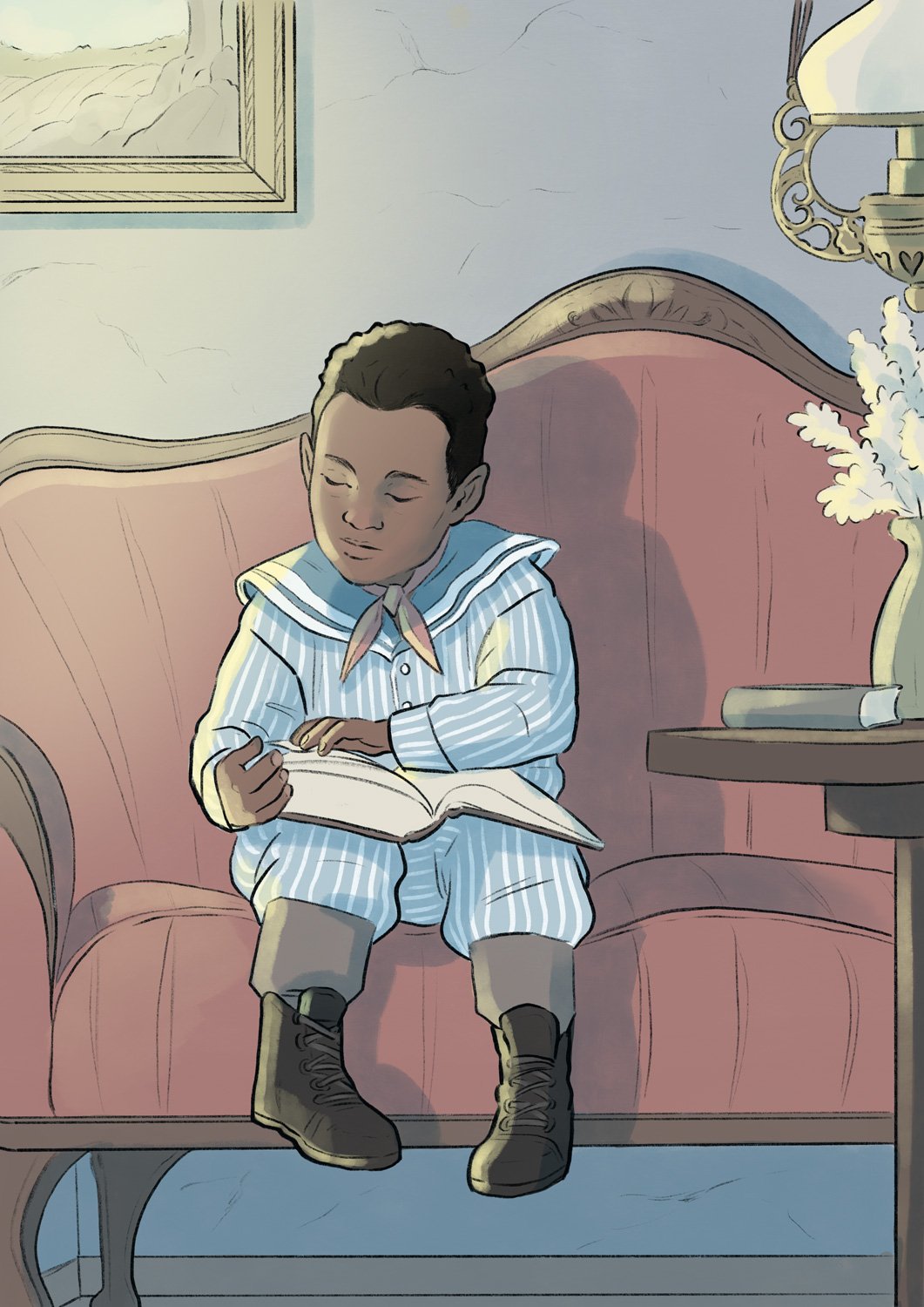
In spring 1875, when returning home from Southern Africa, Gustav de Vylder also brought an African foster son. The little boy was born around 1868 in the Kalahari Desert in what is now Southeast Namibia. His family belonged to the San (Bushmen) people who populated large parts of Southern Africa. Following is Gustaf de Vylder's diary account for how the boy ended up with him in Omaruru on Saturday 7 November 1874:
'Worked on my barrels which are now almost finished, only the clasps are missing. In the evening, Mr. Eriksson and I sat conversing with his mother-in-law when he showed me a Bushman boy, lying sleeping in a box. Mr. Eriksson had bought the child, almost dead from starvation, from a bastard whom he had paid with a rifle. The child's parents had been killed by a bastard, and the child had since been passed around. Mr. E only bought the child to save it from starvation. Mr. Eriksson had the kindness to give me this child, and my desire to have a Bushman child was thus fulfilled. Mr. E had given a rifle, costing 5 pounds, for the boy. The child has been given the name of Joseph, which suits him rather well as, like the patriarch, he too was sold by his brothers. He comes from the Onguaoa tribe.'
A few days later, Gustaf de Vylder writes about having blue and white cotton trousers sewn up and buying new fabric for a coat and hat 'for my son Joseph.' On Christmas Eve that same year, he writes: 'In the morning, we slaughtered a sheep. In the evening, Joseph and I were invited to Mr. Bohman where a Christmas tree made out of an Oromborobonga tree, the holy tree of the Damara, and a table with Christmas gifts, including Christmas gifts with inscriptions for us all, had been arranged. I received a Bible and an ABC book, both in the Herero language, as well as three pairs of socks by Mrs. Bohman; Joseph received Christmas cakes, a mouth-organ (harmonica), a caoutchouc ball (rubber ball), a shirt, and a pair of trousers. After a prayer and singing, the doors were opened, and all the people could look at the lovely Christmas tree. Afterward, we sat talking to Mr. Beidebeck until late in the evening. I gave my servants Christmas gifts of essential clothing, smoking pipes, and tobacco.'
In March 1875, Gustaf de Vylder and Joseph set out on the first leg of their long journey to Europe, from Walvis Bay, towards the Cape. The entire trip took five months. When Joseph and Gustaf de Vylder finally arrived in Sweden, they stayed in Skåne. They spent the summer months in Simrishamn with Gustaf's sister, Maria, her husband Seved Ribbing, and their little son Gustaf Sigfrid, who was then two years old.
They eventually made their way by train to Stockholm, where they arrived one evening in early September. Here they settled near Hötorget, and lived for some time at the intersection of Klara Norra Kyrkogata and Kungsholmsbrogata (now Gamla Brogatan). De Vylder's fatherly love for Joseph appears warm and sincere in his diary. However, he had no scruples about showing the boy while giving scientific lectures on Africa, among others, at the Royal Swedish Academy of Sciences (Wallingatan 2) in October 1875. One newspaper reported: 'although Joseph's mother tongue was unfamiliar to other residents of the Cape area, he had shown an extraordinary ability to learn to speak languages' and was already proficient in Damara, Dutch, English and Swedish.
After that, everyday life ensued for a couple of years. Perhaps Joseph attended school and learned to read and write. However, when Gustaf de Vylder got the chance to go on a long journey to Africa again in 1879, he left Joseph with a foster family in Skåne. His sister Maria Ribbing most likely mediated contact with farmer Mårten Andersson in Lunnarp, not so far from Simrishamn. Joseph lived there and eventually died of tuberculosis (TB) in November 1880. He was then around twelve or thirteen years old. Joseph is buried under a simple cross, next to the church with the pointed tower in Kverrestad.
Sources
Information about the life of Joseph de Vylder was sourced partly from the Swedish press at https://tidningar.kb.se
and partly from Gustaf de Vylder's diary (available in English from Google Books): The Journal of Gustaf De Vylder: Naturalist in South-Western Africa, 1873-1875
Joseph's life was the inspiration for at least two works of fiction: Birgitta Hellgren's 'Bara till låns' (1993) (Only on loan) and Henning Mankell's 'Vindens son' (2000) (The Son of the Wind).